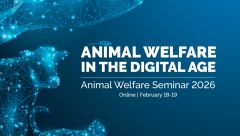Over 12 million Atlantic salmon are farmed every year in Tasmania. The scale of this production brings with it a lot of animal welfare issues.
While some of the animal welfare issues are unique to the aquatic environment, some of the animal welfare issues with salmon farming are similar to those we find in land-based farming systems for other animals. Read on to find out more.
Can fish feel pain?
Firstly, a note on sentience – a term we use a lot in animal welfare science.
Fish are sentient, which means they can experience different feelings, including pain and pleasure, although there is ongoing debate about this in the scientific community. In terms of the public, understanding of fish sentience is lower than other species. For example, a survey of Australians in 2018 found that 23% considered fish to be sentient, and 52% somewhat sentient (with 25% saying ‘not sentient’) – a much lower percentage than other animals farmed for food, like cattle, sheep, pigs and chickens.
But, scientific evidence shows that fish do feel pain – which has enormous implications for how we should be thinking about animal welfare in fish farming. We know that Australians care deeply about the welfare of farmed animals like pigs and chickens in land-based systems so, we can’t forget fish welfare when it comes to thinking about how fish are farmed in aquaculture systems.
Stocking density
One concept that Australians are very familiar with is stocking density – the number of animals in a given space (or, to put it another way, the space available to each animal). It’s something the egg industry, for example, has been very good at marketing – as any trip to the egg aisle in a supermarket and the free-range egg cartons proudly boasting a low number of hens per hectare will tell you.
It’s not a like-for-like comparison, but for fish, the basic principles are the same. High stocking densities (i.e., more animals in one space) can limit the ability of animals to perform natural behaviours, and make animals more susceptible to injuries, infections and disease. For Atlantic salmon this is the case as well – for example, salmon naturally school (all move together at the same time) when they swim, but also need to have enough space to move away from each other if they want to. Fish should be able to decide for themselves where they swim in the water column at any time based on, for example, water temperature, light levels, and available oxygen.
Handling and transport
Any farmed animal gets handled multiple times throughout their lifetime. This can be harmful to the animal if not done well, and may cause stress and suffering. It’s rare in farming that an animal’s entire life cycle takes place in one location– for example, where they’re born, where they’re raised and where they’re killed are often different facilities and the animals need be transported between them – something that can result in stress, injury and death in some circumstances.
Farmed Atlantic salmon are handled frequently during their lives. This includes moving fish through water-filled pipes for grading (sorting by size), bathing (a process to dislodge parasites from the gills) and for slaughter. Handling moving, and transporting can be a stressful experience for fish. Because of the nature of how salmon are farmed, fish are transported multiple times throughout their lives – they spend 10-16 months on land growing in fresh water tanks and then 14-18 months in sea pens, before being ready for slaughter.
Slaughter
Slaughter, the killing of an animal for food, can result in pain, suffering and distress. Before slaughter, fish may be fasted for a few days in order to reduce their oxygen demand, which makes them better able to cope with the transport and slaughter process. Fish are then corralled in the water and and either transferred through water-filled pipes to a specialised ‘slaughter boat’ or to a large ‘well boat’ that transports fish directly to slaughter. Common practice is the use of automatic stunning systems that give a blow to the head, rendering the fish immediately unconscious.
Stunning is an absolutely crucial part of the slaughter process to ensure animals are unconscious and don’t experience pain and distress while they bleed out. But some slaughter practices may result in ineffective stunning, which can cause pain and suffering.
What can be done?
Like with land-based farming, there are also animal welfare issues with Atlantic salmon farming.
The RSPCA continues to advocate, to the Tasmanian government (as all salmon farming in Australia occurs in Tasmania) and to the salmon industry, for measures like research that focuses on fish environment, behavioural interactions, and mental state; optimal stocking density in the Tasmanian context for both freshwater (land based) and marine phases of Atlantic salmon production; and a comprehensive fish welfare assessment protocol.
In the meantime, we also have the RSPCA Approved Standard. This is a set of requirements that producers must meet and be assessed against to achieve RSPCA Approved certification. We only have Standards for six animal production areas (chickens, pigs, turkeys, egg-laying hens, dairy veal calves and farmed Atlantic salmon) – and it’s precisely because of the potential welfare issues we’ve described above (and more) that the Standard exists.
And finally, this brings into need the sharp focus for better legislation to protect salmon as currently there is no legislation specific to the welfare of farmed Atlantic salmon. Regulation is focused on managing and monitoring the environmental impact of salmon farming, but not welfare. There’s also no national Australian Animal Welfare Standards and Guidelines for farmed Atlantic salmon, like there are for many other farmed animals – and so we continue to advocate for this to be created.
In part 2 of this series, we look at some of the unique challenges that being in an aquatic environment poses for Atlantic salmon welfare, such as water quality and environmental impact.







